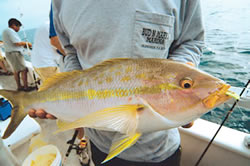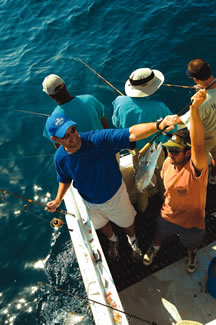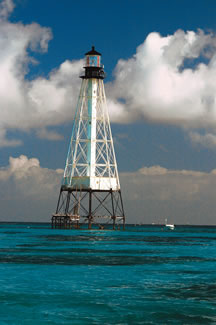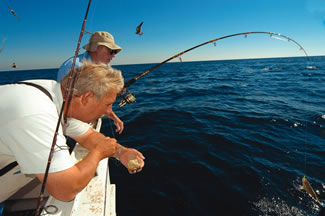August 31, 2011
By Joe Richard, Assistant Editor
Tricky, but worth the effort.
By Joe Richard, Assistant Editor

Tricky, but worth the effort.
|
Okay, this was getting frustrating. Catching yellowtail snapper was proving to be tricky, compared with countless red snapper I've dragged from the depths in the past 30 years. On a whim I'd jumped on the partyboat Miss Islamorada out of Bud N' Mary's in December, instead of heading back to Miami a day early. We spent the entire day anchored in 90 feet of water in gorgeous weather, which was nice. But Jemus H. Croakus; the old-timers on the stern were stacking up the yellowtails, while my bait went ignored.
Soon enough the fishbox began to fill; our deckhand Ben Loy was busier than a one-armed drummer, marking every fish and icing them.
These guys had to be near their limits, all nice fish that never required measuring. Somehow I still didn't have a yellowtail on the boat...I'd dallied instead with an abundant supply of schoolie kingfish, flipping them live cigar minnows with the boat's 30-pound spin gear, which was fun for hours. Now it was time to make hay, so to speak, before we pulled anchor.
There were problems: The new 15-pound line on my personal spin outfit had caught only a few bonito. The yellowtails were ignoring it, though still smacking the deck only a few feet away, courtesy of the pros. The little hook-and-sliding egg weight combo just wasn't doing the job, even with a strip of ballyhoo bait cut exactly like they were using. A red snapper would never make these fine distinctions, not in a million years—but then, I was no longer on the northern Gulf.

The stern position is coveted for yellowtail fishing, and weekends like this are more crowded. Weekday trips offer twice the deck space, and that's when the old-timers show up to really whack these fish.
|
So, for about the third time ever, I asked and then borrowed what the other guys were using. It was a small, fluorescent yellow jighead, tipped with a small strip of ballyhoo. The guys carried these jigheads in a small plastic box not much bigger than a pack of cigarettes. Matching jig weight with the current is important, and on this day with calm conditions and a barely moving current, my questing, bait-covered fingers eased a 1/16-ounce head from the little box.
By then I had switched to a reel from the duffle bag rigged with correct 10-pound line. But there was more to learn. Dropping the jig over the side whenever convenient wasn't going to catch much either. The pros on the stern had it down to a science. Here's what they were doing:
Our vessel kept two chumbags over the side, but the fish never rose higher in the water column this day than about 60 feet. (Perhaps they weren't that hungry, or the water too calm). So, these wise guys were balling up a mix of sand and oats, which the boat provided in ample supply. Add a little water, firm up the mix, dig a hole in the sandball and hide the jig and bait inside, cover it up and pack it tight. After that, flip the bail on the spinning reel and make at least 15 wraps of your line around the ball, in all directions, like a ball of sandy yarn. The darn thing by then looked like it would bounce off someone's head, if you threw it.

Schoolie kingfish are fairly dependable here during winter. Best eating size, too.
|
Instead you drop the sandball over the side, where it plummets down a long way, your spin reel flipping line out rapidly. This line deployment is aided by a wet hand (recently cleaned by slapping in a bucket of seawater), to facilitate a smooth drop.
Even that wasn't enough. You had to time the sandball toss just right, as the anchored boat began a swing away from your side of the boat. If not, the vertical comet of unraveling sand and chum, and perhaps your line, would disappear under the boat, perchance to tangle in the rudder or other lines. Timed right, the entire sandy streak drifted 10 to 20 feet off to your side, whether starboard or port, leaving plenty of room for a hookup. The boat's pendulum anchor swing (in 90 feet of water) seemed to last about four minutes but was probably less.
The sandball disintegrated at 50, perhaps even 60 feet down. From then on, you had to pull more wraps off the reel in a stealthy manner, allowing the jig to sink even more, but in a controlled and slow fashion similar to chum. There was no yanking on the rodtip to pull line off the reel; that only alerts the fish. Give that jig a false jiggle and yellowtails know perfectly well that, “something ain't right in the state of Denver,” as Archie Bunker used to say.

Another day in paradise--Alligator Light in winter.
|
At this point, these guys studied their line rather closely, watching for the slightest tap or twitch. There was real concentration; no gabbing or horseplay while waiting for that next bite. When it happened, they reeled in the slack and struck. A few fish were missed, but not many. When these yellowtails hit, they don't nibble or peck. Time and again, hooked yellowtail fought to reach bottom, but were stopped short. We were fishing more vertically than normal in this light current—that gave the fish less line to reach bottom, compared with a strong current day with lots of line played out astern.
A first-timer off Alligator Light wouldn't have picked up on all this, but one of the old gents on the stern was kind enough (after limiting out) to giftwrap my jig inside a sandball. Soon enough, my two-piece, 8-foot graphite spin rod, ideal for travel and wide-open spaces, was bowed up double on a good fish. Tougher fiberglass rods (and there were some true veteran scuffed-up outfits from hell brought on board that day) are far more suitable for bouncing off hard, overhead structures and nearby competition on a partyboat; here it's a contact sport. Spin reels were oversize and the rods more suitable for at least 20-pound outfits, but were filled with 10- or 12-pound line instead, often with a 16-pound fluorocarbon leader. Very effective on a slow day when the yellowtails were sulking deep on a light current.
And a satisfying day: using frozen chum hung over the side, and the oats-and-sand mix, 10 anglers had landed at least 70 yellowtails, exactly 20 kingfish and perhaps 20 bonito and blue runners. Someone caught a couple of keeper mangrove snappers as well, and we probably would have had more, if anyone had bothered to fish on bottom. The morning's porpoises had stolen a few fish from us as well, including several kings. That wasn't bad action, considering we could see our dock only a half hour away. That's a sweet run, after you've spent years running 30 to 50 miles offshore for red snapper, sometimes in cruel sea conditions.
Many anglers say the yellowtail action is better than in many years, and the constant chumming helps fatten the local fish population.
Captain Jackie McGuire, who has run Miss Islamorada since 1987 and Captain Jack for years before that, agrees to a point.
Local Tackle |
As it turns out, those little jigheads the guys were yanking out yellowtails with are made right there locally in Islamorada, by Hook Up Lures. Started by Capt. Hank Brown, who guided for 35 years, in 1982. Brown retired; Sid and Linda Sussman bought the business in 2004, and they've been cranking out jigs ever since, some 250 models in six colors.
“We haven't changed anything, they work just fine,” says Linda.
“I'm not sure if they were designed for yellowtail, but they really work for that purpose. Especially 1/16- or 1/8-ounce with a number 2 hook, or the 1/8-ounce in a 2/0 hook.”
Doubtless there are other small jigs which would work with similar results. The key seems to be light weight, with a strong, sharp hook. Some anglers pinch a splitshot above a shortshank bait hook for similar effect.
Advertisement
|
|
“Back 20 years ago, we didn't chum with sand and oats. We'd just shake the chumbag and hope the yellowtails came up. It was primitive by today's standards. Today we do a lot more heavy sandballs and oats, along with chum. So the fishing is better; it's a lot easier now than years ago. When we get ‘em going, they charge after the chum. You get a lot more bites,” he said. “If it's choppy out there, they seem to feed better. Really calm weather can be tougher. This is a year-round fishery, right out in front of the marina.”
They certainly had me hooked. I went back the very next weekend, with some heavier tackle and balloons, since we had sailfish jumping around the boat and some bigger kingfish were skyrocketing on the previous day. Jackie says they fly a kite with live bait when they have a decent breeze, adding to the day's excitement. He grabs each hooked sailfish with leather gloves by the bill, unhooks and releases it.
I would rather have fought big kings like a champion from the boat's upper deck, but there was another lesson to be learned about yellowtails. Kings had moved off down the reef by then, and were scarce. The current was more moderate this time, and anglers' lines were drifting much farther back. Captain Jimmy Harris allowed me to set out a balloon line off to the side and far astern, using a live speedo, which were schooling thick around the chumbags. He cautioned me that even a live pilchard on a kite can sometimes spook the yellowtail bite, because a bigger king or barracuda showing sudden interest may send yellowtails scurrying for cover. And that apparently is exactly what happened. Within five minutes, the yellowtail bite (some of the biggest I've ever seen) withered away to nothing. I reeled in the speedo and made myself scarce, but there were no retributions. The sandball crowd on the stern didn't seem to notice, or kept it to themselves, with only a couple of hard glances.

Midweek guys caught yellowtail limits and made it look easy. Sandball ready to throw.
|
Whoops! Live and learn. Better stick with the sandball program. Maybe next time: After bringing home a few plump yellowtails, I now have a kitchen pass to fish Islamorada a lot more often.
FS

